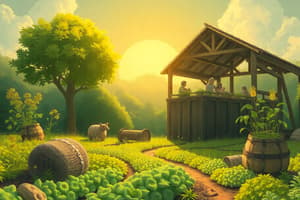Podcast
Questions and Answers
What are some consequences of land use changes due to food production?
What are some consequences of land use changes due to food production?
- Land preservation, wildlife conservation, soil enrichment
- Deforestation, soil erosion, habitat destruction (correct)
- Increased biodiversity, ecosystem services, carbon sequestration
- Expansion of forests, water purification, pollination
In which region has agricultural expansion led to deforestation?
In which region has agricultural expansion led to deforestation?
- Siberian Taiga
- Sahara Desert
- Amazon Rainforest (correct)
- Antarctica
What impact can land fragmentation due to food production have on biodiversity?
What impact can land fragmentation due to food production have on biodiversity?
- Higher habitat protection
- Enhanced ecosystem services
- Loss of biodiversity (correct)
- Increase in species diversity
How does agricultural intensification affect soil health?
How does agricultural intensification affect soil health?
Which of the following is an essential ecosystem service that can be affected by land use changes?
Which of the following is an essential ecosystem service that can be affected by land use changes?
What is one consequence of agricultural expansion on the Amazon Rainforest?
What is one consequence of agricultural expansion on the Amazon Rainforest?
How do invasive species impact natural habitats?
How do invasive species impact natural habitats?
Which invasive species disrupt waterways and affect native mussel populations in North America?
Which invasive species disrupt waterways and affect native mussel populations in North America?
How can land use changes due to food production impact invasive species?
How can land use changes due to food production impact invasive species?
What impact can agricultural intensification, like monocultures, have on native species?
What impact can agricultural intensification, like monocultures, have on native species?
Which invasive animal feeds on over 300 plant species, including apples, peaches, and soybeans?
Which invasive animal feeds on over 300 plant species, including apples, peaches, and soybeans?
What is a potential outcome of the interaction between food production and invasive species?
What is a potential outcome of the interaction between food production and invasive species?
Flashcards are hidden until you start studying
Study Notes
Environmental Impact of Food Production: Land Use and Invasive Species
Food production is a fundamental part of our daily lives, yet its effects on the environment are far-reaching and complex. In this article, we'll explore two interconnected aspects of food production's environmental footprint: land use and invasive species.
Land Use
Land use changes due to food production can lead to deforestation, soil erosion, and habitat destruction. As our global population grows and food demand increases, agricultural land is expanding to meet this need, leading to deforestation in some regions. The Amazon Rainforest, for instance, has been experiencing agricultural expansion, with large swaths of forest cleared for farming and livestock.
Moreover, food production often results in land fragmentation and loss of biodiversity. This can lead to a decline in ecosystem services, such as water filtration, pollination, and carbon sequestration, all of which are essential for maintaining healthy environments.
Agricultural intensification, while increasing productivity per unit area, can lead to the depletion of soil health. Intensive farming practices, such as the use of monocultures, excessive fertilizer application, and tillage, can reduce soil organic matter, nutrient content, and structure, thus decreasing the land's ability to absorb and store water.
Invasive Species
Invasive species in agriculture can be both plant and animal, and they can have significant impacts on the environment, food production, and natural habitats. Invasive plants can outcompete native species, alter ecosystems, and reduce habitat availability for native species. For example, the Chinese tallow tree and the water hyacinth are invasive species that have disrupted ecosystems in the United States.
Similarly, invasive animals can alter agricultural ecosystems, reduce crop yields, and spread diseases to native species. For instance, the brown marmorated stink bug has spread through North America, feeding on over 300 plant species, including crops such as apples, peaches, and soybeans. The zebra mussel, an invasive species in North America, has clogged waterways, reducing water quality and affecting native mussel populations.
Interactions Between Land Use and Invasive Species
Land use changes due to food production can also create conditions that favor invasive species. For example, deforestation disrupts natural habitats, making it easier for invasive plants and animals to colonize new areas. Agricultural intensification, such as the use of monocultures, can reduce the abundance of native species, thus reducing the natural defenses against invasive species.
Moreover, food production and invasive species can interact in complex ways, leading to a range of outcomes. For instance, the spread of invasive species can lead to land degradation and reduced agricultural productivity. On the other hand, invasive species can sometimes be beneficial to food production, as in the case of the yellow crazy ant, which protects coconut plantations from invasive rodents in the Pacific islands.
Conclusion
Food production is essential for global food security, yet its environmental impacts are significant. Land use changes and invasive species are two areas that particularly impact the environment. Understanding these challenges is crucial for developing sustainable food production systems that minimize negative environmental impacts and maximize benefits for both people and ecosystems. While there are no simple solutions, addressing these challenges requires a multidisciplinary approach that includes research, policy, and practice in agriculture, ecology, and conservation.
Studying That Suits You
Use AI to generate personalized quizzes and flashcards to suit your learning preferences.




